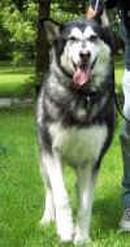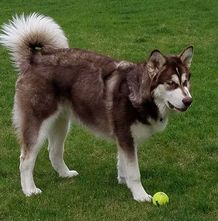Standard Versus "giant" Alaskan Malamutes
I’ll admit it: I was once enamored by 'giant malamutes.' I was young and, like so many others, seduced by their impressive size, oftentimes epic wooly coats, and perceived rareness. As I continued to study under the tutelage of respected breeders who care with every fiber of their being for the health and integrity of the breed, however, the more disillusioned I became with 'giants.'
What is the standard?
|
The standard is a description of the *perfect* Alaskan malamute as written by early advocates of the breed in their attempts to get the Alaskan Malamute officially recognized by the American Kennel Club (AKC). The standard identifies a malamute as a malamute, easily discernible from any other breed (i.e. Siberian husky, Samoyed, Tibetan Mastiff, Akita, or Great Pyrenees).
The standard essentially reflects and supports the original function and integrity of the breed. It protects the malamute from extremes that might reduce its ability to work. You should be able to look at any malamute and image it in harness, pulling a heavy load through arctic conditions for mile upon mile. The standard is a guideline for the preservation of the breed. |
|
How did the 'founders' decide what was ideal?
What does a 'standard' Alaskan Malamute look like?
 Dory, Bobbi, and Nero.
Dory, Bobbi, and Nero.
Alaskan malamutes are a moderate breed. Angles should be balanced and shoulders well-laidback to contribute to powerful reach and drive. Every step on the trail should count. Movement should be effortless and smooth. The gait should converge when coming at you or moving away. While slower than their Siberian counterparts, malamutes are capable of pulling greater weights for longer distances. They are substantial in bone, but compact in size compared to today's 'giants.' This relative compactness lends itself to energy efficiency in the harsh arctic winters.
What is a 'giant' malamute?
|
There is no such thing as a 'giant' malamute. All malamutes go back to the same foundational stock. To produce that larger size, breeding pairs are selected based on size alone, rather than fundamentally important qualities such as: health, structure, type, and temperament. After several generations of this tunnel-vision breeding, the dogs become bigger and bigger, but because those other qualities fall by the wayside, they often look off and not quite like a malamute. And their health suffers.
These puppies tend to command inflated prices due to their size and perceived rarity. |
Why are 'giant' malamutes unhealthy?
|
Problems occur when one focuses on looks (i.e. size and color) over substance (i.e. health, structure, temperament, and type). With increased size and weight come sundry health issues - shorter life spans, hypothyroidism, elbow dysplasia, and hip dysplasia. Hip problems are rampant in 'giants.' In various social media groups, one might observe puppies as young as 6 months being diagnosed with hip dysplasia. Others might suffer invasive ACL surgery before 4 years of age. Their massive weights, poor structures, and owners' drive to have the 'biggest dog' (oftentimes by allowing them to become grossly overweight) put immense strain on bodies never meant to reach that size.
|
|
To make matters worse, most giant breeders do not complete health checks on their breeding stock. Studies suggest that several of the above afflictions have a strong genetic component, including but not limited to hip and elbow dysplasia. Breeding only those dogs that pass their health checks is a breeder's responsibility to both the breed and their future puppy people.
Check the Orthopedic Foundation for Animals (www.offa.org) database; you’ll be hard-pressed to find many giant breeders on there. These tests are expensive and identified issues can reduce one's viable breeding stock, neither of which would align with a program focussing on profit. Of note: I am personally aware of at least 4 local 'giant' malamutes (from various breeders) that passed away before the age of 6. |
But those puppy videos are cute!
|
We've all seen those videos surfacing from Asia - you know, the bundles of puff that look more like cotton balls with legs. These are NOT malamutes. They are mixes: Tibetan mastiffs/chows/what-have-you bred into the line to produce massive size and excessive coats. They look nothing like malamutes (save the markings). Watch those puppies attempt to move. They cannot gait fluidly. Their stubby legs can only bounce. Imagine the horrendous shock placed on those growing joints from all that hopping! These puppies will likely have a plethora of issues as they age. They could never pull a sled for mile upon mile!
|
But I don’t want/need show lines or champions in the pedigree.
 Ch Anua's Absolut Clara-T
Ch Anua's Absolut Clara-T
Dog shows - also called 'conformation' - are not the enemy! Conformation is simply a way to hold individual dogs up to the standard. How well do they literally conform to that ideal malamute? Yes, dog shows involve some spectacular grooming. Yes, we prance around the ring looking entirely too serious for what we are doing (running our dogs in circles while wearing skirts). There is a reason behind all of it! Gaiting around the ring showcases the animal’s movement. Are they balanced (front angles match their back angles)? Do their back feet fall in the spots vacated by the front? Do they reach with their front legs? Do they drive with their back legs? Do they converge into a centerline coming and going? Does their topline flow smoothly? Does everything look effortless? Those dogs that best meet all of the above win points towards their championships.
Champions are dogs identified as having ‘conformed’ well to the standard. This is a good thing! These dogs (and their offspring) will have the physical capacity to hike, jog, skijor, bikejor, mush, and do anything else you could want from a companion!
Champions are dogs identified as having ‘conformed’ well to the standard. This is a good thing! These dogs (and their offspring) will have the physical capacity to hike, jog, skijor, bikejor, mush, and do anything else you could want from a companion!
|
Too often, I hear people claim to not want or need show lines or champions in their dog's pedigree. If you avoid these breeders, you deprive yourself of the careful study and breeding of those who hold the health and function of their dogs in the highest regard. You lose the benefit of the structural soundness they breed into their dogs, which will allow them to be active and healthy members of the family for years upon years. By avoiding these breeders, you commit yourself to years of potential hardship and vet bills.
|
 Nero and Vesta.
Nero and Vesta.
What I believe these people mean is: they do not desire ‘show quality.’ No problem! That does not mean one cannot go to a show breeder. Every litter will have pet-quality pups. Long-coats, for example. Breeders are usually tickled pink to find homes willing to tackle such a coat (LOTS of upkeep!). Most litters will have 1-2 long coats, if the parents are carriers. Other puppies may simply have cosmetic or structural qualities that they do not wish to breed, but will make fabulous family members, hiking partners, and snugglers. Go to a breeder that shows (and, BONUS, works their dogs) and you get the benefit of their years of hard work and dedication.
In Conclusion...
|
Go to reputable breeders that breed standard-sized dogs! Find one with comprehensive knowledge of the standard, history of the breed, pedigrees, structure, and genetics and health issues (e.g. HD, PN, CHD, epilepsy, etc). Find a breeder whose mission is to improve the breed in all aspects. Find a breeder who keeps the original function of the malamute in mind with every litter. The breed’s survival and our individual dogs’ health and happiness depend on it!
|
AUTHOR Julia Berquist
EDITOR Karin Fischer
Photo Credits: Illustrated Standard, IAMR, Christy and Kyle Bell, Karin Fischer
EDITOR Karin Fischer
Photo Credits: Illustrated Standard, IAMR, Christy and Kyle Bell, Karin Fischer










